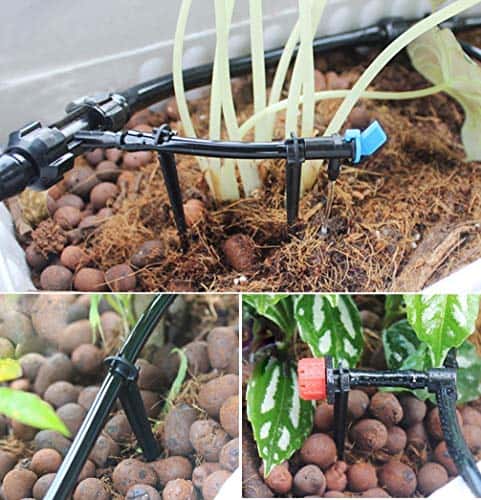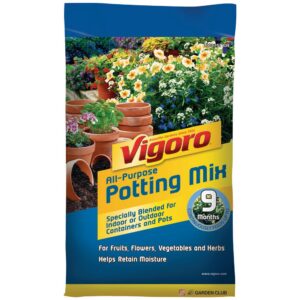Watering tomatoes with a drip irrigation system is one of the best techniques. Take a look at this comprehensive guide for answers.
Growing tomatoes in your garden can be fun. The only challenge the gardener faces in growing a juicy plant is watering or providing sufficient water per its daily requirement. The roots of tomatoes get dried quite often. So, it’s the rightful duty of a planter to keep the tomato plants hydrated.
Experts say the best way to raise juicy tomatoes is to provide water to their roots. Each tomato seed requires a constant touch of moist soil. Unlike any fully mature plant, a tomato plant can grow with water on its foliage, leaving the leaves dry. Two available techniques can facilitate the irrigation of tomatoes. You get a farm full of red and juicy tomatoes by doing so.

Read Next
- Are You Thinking Of Watering Tomatoes With Drip Irrigation?
- What A Tomato Plant Needs
- 1. Drip Irrigation Kit
- 2. Where To Plant
- 3. Setting Up The Drip Irrigation System
- 4. Determine The Distance
- 5. The Role Of Backflow Preventer And Pressure Regular
- 6. Points To Keep In Mind While Installing Drip Irrigation System
- 7. Timing Is Important
- Conclusion: Drip Irrigation Is A Dependable System
- 💬 Feedback
Are You Thinking Of Watering Tomatoes With Drip Irrigation?
You must be wondering what makes watering tomato plants with a drip irrigation system one of the best techniques. Well, a drip irrigation system utilizes a small tube that delivers water directly to the base of a plant.
Watering tomato plants with drip irrigation concentrates more on irrigating the plant. It’s quite an easy way to supply water to tomato plants. Since drip irrigation is an effective and smart way of preventing water from getting wasted, it’s a good way for planters to go with this type of irrigation.



What A Tomato Plant Needs
Before you plan to set up an irrigation system, you must access the water needs of the tomato plants. You can check if the tomato plant is water thirsty by placing your finger two inches deep into the soil. You should know it’s time to water it if it comes out dry.
Let’s learn how to water tomato plants using a drip irrigation system.
1. Drip Irrigation Kit
Once you decide to install an environmentally sound drip irrigation system, refer to an installation guide to have some basic knowledge about the parts required. You can also use a drip irrigation kit to simplify the process.
Make sure you purchase a kit depending on the size of your farm. The all-inclusive drip irrigation kit includes a spigot, timer, backflow device, filter, pressure, and swivel adaptor.



2. Where To Plant
Place a tomato plant by digging out a circular area about 3 inches deep and 1 foot across. This way, you can provide deep watering to plants as required. A 3 inches space can also prevent the plant from getting infected by a disease.
3. Setting Up The Drip Irrigation System
Make patterns in L or T-shapes by using connectors. Ensure that the proper amount of space and light reaches each tomato plant. Next, set a single line in the middle of the tomato bed. Each tomato plant requires watering regularly to blossom.
A well-placed drip irrigation system at 20cm-30cm can provide water to a range of 0.7 and 1.6 liters per hour.
4. Determine The Distance
Starting from the hose outlet to the tomato patch, it is important to determine or measure the distance of the tubing. Place the tubing 400 feet under the ground. Let it get warm in the sun. Using a hose bib, join the ends of the tubing to the garden hose outlet.
Be careful while moving the sub-main or tubing. It is flexible enough to take the shape of your garden. Keeping in mind the distance between the plant and the emitter, put two emitters on either side of the plant.
5. The Role Of Backflow Preventer And Pressure Regular
Installation of a backflow preventer and a pressure regulator is a must. Ensure you keep both things connected with the faucet of your garden hose. Next, align the garden hose from the faucet to the drip system.
6. Points To Keep In Mind While Installing Drip Irrigation System
The installation process of drip irrigation is complex compared to the soaker hoses. Align two or more soaker hoses. You have to be careful about the placement of the hose. Make sure it is placed deep inside the depression (the point where you have planted).
7. Timing Is Important
The watering of tomato plants with a drip irrigation system should be run once an hour. Ensure you water the tomato plants when a flower begins to bloom and set fruits. Regular watering of plants helps eliminate stress from your plants. It also maintains the moisture of the soil.
To keep the irrigation process effective, it is important to schedule it. A timer can also be installed as per your requirement. Program your timer and let your garden water itself. Now, you can do something else while your tomatoes are watered at the right time.
Watering of tomato plants with drip irrigation is dependent on weather conditions. In extremely hot weather, you need to monitor the requirement of water. You may run the system twice a day. It replenishes the water.
Watering the tomato plants with drip irrigation allows for moistening the plant's close base. A damp soil inch from the plant does not ensure the water has reached its roots. However, ensure that there are no puddles around your tomato plant. This shows that you have watered too long.
Conclusion: Drip Irrigation Is A Dependable System



A gardener should be aware that the water requirements of a plant change with its growth. Many variables, such as temperature, humidity, root depth, and sunlight hours, should be considered. You can also make manual adjustments in the end by ensuring that water is hitting the soil as required.
Watering tomato plants with drip irrigation is considered to be a practical solution. It leads to the healthy growth of tomatoes without using extra water. All tomatoes are 95 percent water and should not be left dry for longer.
With an automated drip irrigation system, you need not worry about the tomato plants. Watering tomato plants with drip irrigation often results in the production of a stronger and healthier crop. So, wait no more start growing tomatoes on your kitchen farm by adopting this technique.





Comments
No Comments